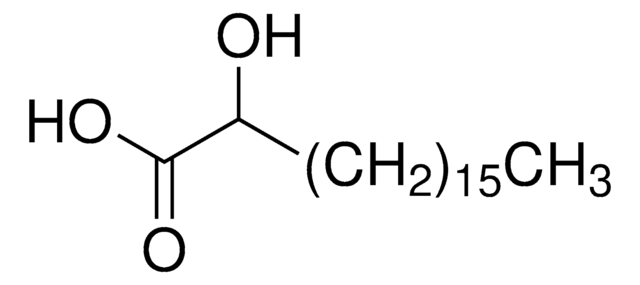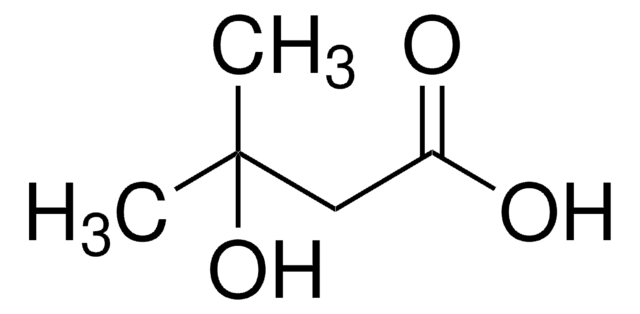H4398
DL-β-Hydroxypalmitic acid
≥98%
Synonym(s):
3-Hydroxyhexadecanoic acid
Sign Into View Organizational & Contract Pricing
All Photos(1)
About This Item
Empirical Formula (Hill Notation):
C16H32O3
CAS Number:
Molecular Weight:
272.42
MDL number:
UNSPSC Code:
12352211
PubChem Substance ID:
NACRES:
NA.25
Recommended Products
Assay
≥98%
form
powder
functional group
carboxylic acid
lipid type
saturated FAs
shipped in
ambient
storage temp.
2-8°C
SMILES string
CCCCCCCCCCCCCC(O)CC(O)=O
InChI
1S/C16H32O3/c1-2-3-4-5-6-7-8-9-10-11-12-13-15(17)14-16(18)19/h15,17H,2-14H2,1H3,(H,18,19)
InChI key
CBWALJHXHCJYTE-UHFFFAOYSA-N
Biochem/physiol Actions
DL-β-Hydroxypalmitic acid is a mixture of D- and L-β-hydroxypalmitic (3-hydroxyhexadecanoic) acids. 3-hydroxyhexadecanoic [C16:0(3-OH)] may be used in studies that involve the lipid structures of endotoxin lipid A molecules.
Storage Class Code
11 - Combustible Solids
WGK
WGK 3
Flash Point(F)
Not applicable
Flash Point(C)
Not applicable
Personal Protective Equipment
dust mask type N95 (US), Eyeshields, Gloves
Choose from one of the most recent versions:
Already Own This Product?
Find documentation for the products that you have recently purchased in the Document Library.
Customers Also Viewed
Nina Wiedmaier-Czerny et al.
Journal of chromatography. B, Analytical technologies in the biomedical and life sciences, 1162, 122454-122454 (2020-12-30)
Bacteria show distinct and characteristic fatty acid (FA) patterns which can be modified by environmental conditions. In this study, we cultivated six plant-pathogenic bacteria of agricultural concern and performed a detailed analysis of the fatty acid composition. The study covered
P Vadovic et al.
Acta virologica, 51(4), 249-259 (2008-01-17)
The composition and structure of lipid A isolated from the lipopolysaccharide (LPS) of Piscirickettsia salmonis were investigated by chemical analyses, gas chromatography/mass spectrometry (GCMS), and electrospray ionization (ESI) combined with the tandem mass spectrometry (MS/MS). Our study revealed moderate compositional
A B Flavier et al.
Molecular microbiology, 26(2), 251-259 (1998-02-12)
Expression of virulence genes in Ralstonia solanacearum, a phytopathogenic bacterium, is controlled by a complex regulatory network that integrates multiple signal inputs. Production of several virulence determinants is coordinately reduced by inactivation of phcB, but is restored by growth in
A Fjellbirkeland et al.
Archives of microbiology, 168(2), 128-135 (1997-08-01)
Membranes obtained from whole-cell lysates of Methylococcus capsulatus (Bath) were separated by Triton X-100 extraction. The resulting insoluble fraction was enriched in outer membranes as assessed by electron microscopy and by the content of beta-hydroxy palmitic acid and particulate methane
R P Garg et al.
Molecular microbiology, 38(2), 359-367 (2000-11-09)
In the phytopathogen Ralstonia (Pseudomonas) solanacearum, control of many virulence genes is partly mediated by the Phc cell density sensing system. Phc uses a novel self-produced signal molecule [3-hydroxypalmitic acid methyl ester (3-OH PAME)], an atypical two-component system (PhcS/PhcR), and
Our team of scientists has experience in all areas of research including Life Science, Material Science, Chemical Synthesis, Chromatography, Analytical and many others.
Contact Technical Service
















